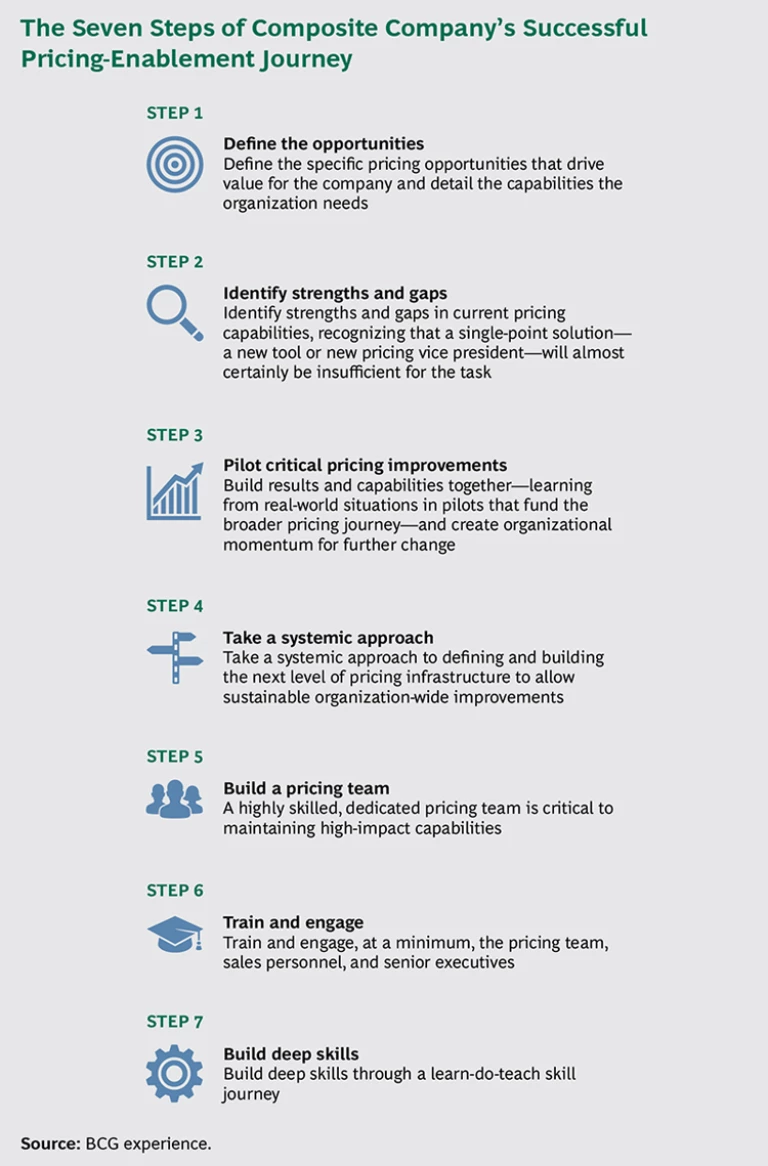Pricing goods and services is the language of business. It is the way a company communicates to customers—and reveals to competitors—the value of its products. This primary role makes strong pricing capabilities exceptionally valuable—in all industries and around the world.
In our experience, companies that significantly upgrade their pricing capabilities, in many cases, boost annual revenues by 2 to 8 percent—and virtually all of that gain flows directly to the bottom line. At large companies, pricing enablement programs routinely increase profits by hundreds of millions of dollars. In many industries, particularly those with tight margins or slow growth, pricing is a critical generator of enhanced profitability or additional cash to invest in marketing and innovation. Superior capabilities provide a powerful competitive advantage that differentiates a company in the eyes of customers and investors.
Still, relative to the potential benefits, most companies underinvest in pricing prowess. More than half have no formal analytic-pricing teams and many have only basic pricing capabilities.
Even the companies with the most sophisticated approach to pricing routinely find significant opportunities for improvement. That’s because there are literally dozens of effective pricing strategies, and even the best companies employ only a small fraction of them. Today’s markets are dynamic. The data and tools available for pricing optimization are rapidly improving. The competitive imperative to improve pricing capabilities is strong.
A decade ago, revenue management by airlines represented the most advanced pricing practice: they dynamically adjusted prices as tickets were purchased. Today, however, companies in many other businesses—from retailers such as Amazon.com that adjust prices in real time on the basis of customer viewing and buying behavior, to B2B manufacturers that capture win-loss information after each deal and leverage it to set more scientific price targets—have made step change advances in pricing sophistication. Airlines themselves have brought new levels of strategic insight and deeper understanding of data to their pricing decisions.
As Complexity Grows, Even the Best Must Get Better
The growing complexity, sophistication, and competition in the art of pricing mean that even the best can—and must—get better. What holds companies back? Pricing is a complicated function for sure, and some companies underinvest in it because they consider changing prices risky and because measuring improvement is difficult. Without a deep understanding of how their behavior affects prices, many executives attribute gains and losses to “the market” rather than to their own capabilities or actions.
In addition to measurement challenges, several pricing myths keep senior leaders from taking action. Although there are elements of truth in each of the following statements—which may sound familiar from conversations at your own company—the barriers each describes are far less daunting than most executives believe.
- Supply and demand set the price. I can’t really control it.
- My sales teams are closest to the customer. They’re the pricing experts and should control decision making.
- I can’t budge on pricing because of competition (or powerful customers or regulators).
- Our organization is world class at pricing. There is little further value available.
In the account that follows, we have bypassed the myths to show how real companies have successfully changed their capabilities through pricing enablement programs. We follow Composite Company—an amalgamation based on The Boston Consulting Group’s experience with hundreds of actual companies and real business situations—as its leaders, managers, and employees proceed through the seven steps of a successful pricing journey. (See the exhibit below.)
Composite manufactures and sells an array of products to other businesses. But its pricing challenges and eventual rewards are similar to those of consumer and industrial companies, retailers, airlines, telcos, financial institutions, and health care providers—companies representing a diverse array of industries.
The Journey Begins with Pain and Opportunity
Pricing enablement programs almost always originate with a challenge, an opportunity, or both. Composite’s journey began as an effort to address difficult circumstances. The company’s market was maturing and revenues and profits were flattening. Leadership grew concerned as competitors became increasingly aggressive, pushing prices down.
Composite had brought in a pricing team and launched a pricing program to help spur growth. But the solutions that resulted were tightly focused on setting prices for new products. The pricing team, essentially an implementation squad, was empowered only to apply pricing decisions dictated from above. Its work yielded few strategic insights, and financial gains were short-lived.
At the company’s June offsite meeting, the CEO challenged the team: “We need to drive profitable growth, or the market is going to kill us. What is the fastest and surest path to achieve that?” The CFO suggested that the company revisit its pricing practices as a lever for growth. She had offered this opinion before, and Bill, the executive vice president of sales, had dismissed it: Composite’s sales team was strong, and its members knew their customers well. This time, however, facing competitors’ increasingly sophisticated pricing, Bill knew that he needed help. He pushed Composite to revisit pricing.
The executive team huddled and set a goal of building world-class pricing capabilities, insisting that the effort drive significant financial results at the same time. They would start small, minimizing risk, but plan for a major effort. Furthermore, to ensure ongoing visibility and support from senior leadership, the team would track progress with scheduled strategy and financial reviews.
Jane, the internal pricing lead, excited about the opportunity but nervous about the daunting task ahead, agreed to take on oversight. This is the story of how she met the challenge and how she and her team became company heroes.
Dispelling Myths and Building Momentum
Jane started the program by asking her team to identify specific pricing opportunities. She knew intuitively that understanding where and how to make more money would help dispel pricing myths that had dogged earlier efforts while building momentum for the new one. Her team organized internal discussions to collect views on the company’s pricing pain points. They conducted market research, including customer surveys and interviews, to understand client needs.
The team segmented Composite’s customer base by market, company size, region, product category and purchase history, and competitive situation. Then, analyzing by segment, the team examined the company’s prices, discounting practices, and profit levels.
As its work progressed, the team identified four opportunities for repricing initiatives to enhance profitability:
- Targeted Discounting. Existing customer discounts, which varied by more than 200 percent, had been granted with insufficient rigor and logic.
- Regional Pricing Optimization. There were large discrepancies in current pricing levels across markets.
- Rigorous Price Increases. Inconsistent and flawed processes characterized the current planning and execution of increases.
- Negotiations with Critical Customers. In the national-account management process—even with major customers—the company conducted ad hoc negotiation procedures with insufficient pricing information and little oversight.
These findings gave Jane her first core insight. Pricing is not a single, unique capability. It is a set of many distinct capabilities. To succeed, Composite’s enablement program would need to be organized to address a specific set of pricing gaps and opportunities.
Step 1. Define the specific pricing opportunities—and the capabilities—your organization needs to drive value.
As the team continued to search for more opportunities, it conducted a pricing maturity assessment—a kind of company-wide pricing-health checkup—benchmarking current practices, skills, and overall pricing fluency against competitors’ capabilities and a broad set of best practices.
The results highlighted critical gaps across comparison areas. For example, Composite was making 30 percent more exceptions to its standard pricing process than competitors and other comparable companies. These results provided a data-based profile of Composite’s specific capability gaps.
The CFO had, from the beginning of the program, voiced her strongly held opinion that the core driver of better pricing success would be a new pricing tool. The maturity assessment dispelled that view, using facts and figures to show that the company lacked the right people, capabilities, processes, organization structure, data, incentives, and governance.
The full executive team now saw that the company needed a broad and nuanced set of solutions. And Jane’s team provided the insights needed to begin prioritizing improvements in pricing capabilities, as well as specific targets of opportunity.
Step 2. Clearly identify strengths and gaps in your current pricing capabilities. Recognize that a single-point solution—a new tool or new pricing vice president—will almost certainly be insufficient.
The team focused on detailing exactly what was needed to benefit from each of the four pricing opportunities. For example, they identified changes that would be needed to improve the national-account management process:
- Establish a cross-functional pricing council to oversee large-account pricing decisions.
- Build pricing dashboards to highlight critical performance data and manage the process.
- Add analysts to the central pricing team in order to obtain information that can improve and facilitate the decision-making process.
- Train the sales team to work within the new process and negotiate in a value-oriented way.
Jane quickly realized that extensive changes would be required for just this one pricing process. And there was still no proof that they would provide the mandated financial impact. She chose to start by piloting the change in a few regions and using bootstrapped tools, a quickly assembled council, which was later refined, and individual-focused sales training. Jane and the team monitored the results carefully to see what worked and where refinement was needed to ensure success.
Within three months, the team had compelling results. The deals prepared and negotiated under the national-account management pilot averaged 5 percent higher price realization than did similar deals under the old system.
Momentum and excitement were building. Jane recommended that the executive committee expand the pilot program. She showed that the initial pricing moves would fund the needed investments in less than a year. And the figures she presented showed that the upside potential of the overall program surpassed $100 million. Not everyone on the committee believed that number, but Jane was increasingly confident.
Three more pricing pilots were launched, and they quickly demonstrated clear results similar to those of the national-account market test.
Step 3. Pilot critical pricing improvements, building results and capabilities together, learning in real-world situations, funding the broader pricing journey, and creating momentum for change.
Now Jane’s team turned to the next task—rolling out the changes across the organization. But the euphoria soon melted away. The team realized, Jane later said, that “implementation across a full organization is hard. You can’t manage it in a bootstrap fashion.”
To address that challenge, the team created a detailed blueprint of the infrastructure elements needed to roll out the major pricing capabilities and embed them throughout the organization:
- Clear processes were mapped for each pricing capability, including, for example, the steps required in the process for annual price increases.
- Well-defined roles and responsibilities across the organization were outlined for each process step.
- Requirements were itemized for data systems, reporting, and analytic tools needed to support knowledgeable decision making.
- Performance metrics were revised to spotlight pricing performance—along with proposed sales incentives aligned with the success of the new pricing initiatives.
- Investment requirements for implementing the capability blueprint were detailed.
Jane developed an implementation roadmap and investment proposal for the creation of the new pricing infrastructure. She prioritized the highest-value capabilities to help fund further investment.
Step 4. Take a systemic approach to defining and building the new pricing infrastructure, identifying the interconnecting elements that will sustain organization-wide pricing improvements.
To achieve success in pricing, the company must build the right infrastructure. But that, Jane realized, is not enough. The company needed a dedicated pricing team to drive initial pricing changes, sustain improvements, and continually adapt to the changing business environment. She created a list of requirements and roles for the new team:
- Individuals with deep analytic skills and strong communication abilities
- A team that does not own decision rights but is equipped to drive and prioritize decision making through skillful analysis and presentation of cogent facts and recommendations to the company’s leaders and sales team
- A team that does not simply execute pricing moves but is also able to influence strategic thinking across the organization
Jane started hiring pricing talent and recruited high-performing company employees to join the new pricing team. She hired a vice president of pricing to oversee the initial team of eight pricing managers and analysts.
Step 5. Build a highly skilled dedicated pricing team—critical for maintaining high-impact capabilities.
The combination of pricing infrastructure and pricing team is extremely powerful, but even that is not enough. Both the pricing team and the broader set of company stakeholders needed to build greater fluency in weighing pricing decisions and implications. Jane created a list of people in the company who needed enhanced pricing skills to make the changes work.
- The pricing team has a clear need for deep and continually expanding skills, including specific analytic capabilities such as making price elasticity calculations and broad scenario modeling, as well as the communication skills required to teach and influence others in the organization about pricing moves.
- The sales team needs appropriate training in order to implement pricing moves—both the understanding of pricing shifts and the appropriate sell-in tactics to persuade customers.
- Senior executives need to understand what type of pricing strategy the company can execute, how to lead the organization in pricing moves, and how to respond when top-to-top customer conversations turn to price.
To avoid bruising executive egos by implying that company leaders did not fully understand pricing, Jane labeled the senior-executive training program “pricing alignment.”
Step 6. Train and engage the pricing team, the sales function, and senior executives. That is crucial, at a minimum. Often, marketing and finance teams are also critical players.
Considering the diversity of groups across the organization, Jane determined how best to conduct the actual pricing training. Sending employees off to business school certainly wasn’t an option. Jane also knew from experience that it would be difficult to translate general concepts into real day-to-day work applications. She and her team elected to follow a learn-do-teach model, which is based on the established science of learning and embedding new skills:
- Learn. Introduce participants to core topics through formal training sessions.
- Do. Apply the new knowledge by executing pricing moves in real-world situations, simultaneously offering online learning for specialized topics and pricing mastery.
- Teach. Certify capable participants and move them into teaching roles to both broaden pricing fluency across the organization and embed the skills.
Jane planned a series of several training waves to develop a cadre of deeply experienced pricing teachers across all of Composite’s functions.
Step 7. Build deep skills through a learn-do-teach skills journey.
Having led Composite’s pricing-enablement journey for a year, Jane paused to catch her breath. Results confirmed the success of her team’s efforts. The company had generated an incremental run rate of $150 million in earnings before interest and taxes on revenues of $4 billion through the broad implementation of pricing improvements. Colleagues and shareholders alike were amazed at the 30 percent jump in profitability the program had generated. The higher profits were funding significant reinvestment and reenergizing the business. The huge step forward in pricing capabilities created enormous confidence in the company’s ability to sustain these improvements into the future.
“We are a far stronger and better monetized organization than we were before we launched our pricing-enablement program,” a board member said. “We could not have driven this value without that initiative.”
A Hard-Earned Competence, Not a Purchased Commodity
Consummate pricing competence is achieved through a set of hard-earned capabilities. It cannot be rented as a service offering or bought as a one-size-fits-all commodity. Pricing acumen cannot be built with a fixed template nor can it be located using a map. Every company’s path to pricing accomplishment will depend on its starting point, competitive circumstances, and strategic goals. Still, successful enablement programs are built on a shared set of best practices. (See “Learning from Success: Principles of Pricing Enablement.”)
LEARNING FROM SUCCESS: Principles of Pricing Enablement
Working with our clients, BCG has found an enduring set of common principles and best practices that can help cement success on the pricing enablement journey. Not adhering to these principles can mean difficulty and even failure. Following, in the words of successful leaders of company enablement programs, are six of the most useful principles.
- Follow the data. Challenge conventional wisdom with facts to find the hidden opportunities.
- Small changes add up to big dollars. Circulate the message throughout the company, from bottom to top: everyone should be involved, and every little bit counts.
- Think from a sales perspective. Develop intuitive tools, such as clearly coded pricing zones. Arm the sales team with fresh data. Introduce structured pricing and negotiating.
- Build your organization’s commitment to change. Embed commitment throughout the company—from the board and executive leadership to line managers and teams.
- Share the gain. Align team incentives with your pricing goals. Emphasize the carrot, not the stick.
- Do it, report it, talk about it. Measure and report pricing all the way up to the board. The senior vice president of sales identifies the top pricing performers in the quarterly updates.
Pricing—along with sales, marketing, and branding—is a fundamental go-to-market commercial capability. It can become the linchpin of your successful strategy to generate profitable growth. If it is properly enabled, you will be able to convince your customers to pay a little more, buy a little more, or—even better—both.
You can, of course, take an incremental approach to the development of your pricing capability. But to really move ahead—and stay there—you need to take a transformational approach by creating a set of strategic pricing capabilities financed with significant short-term profits.
Do this, and you will be truly enabled—and ready to compete in an increasingly fast-paced world marked by disruptive change.










